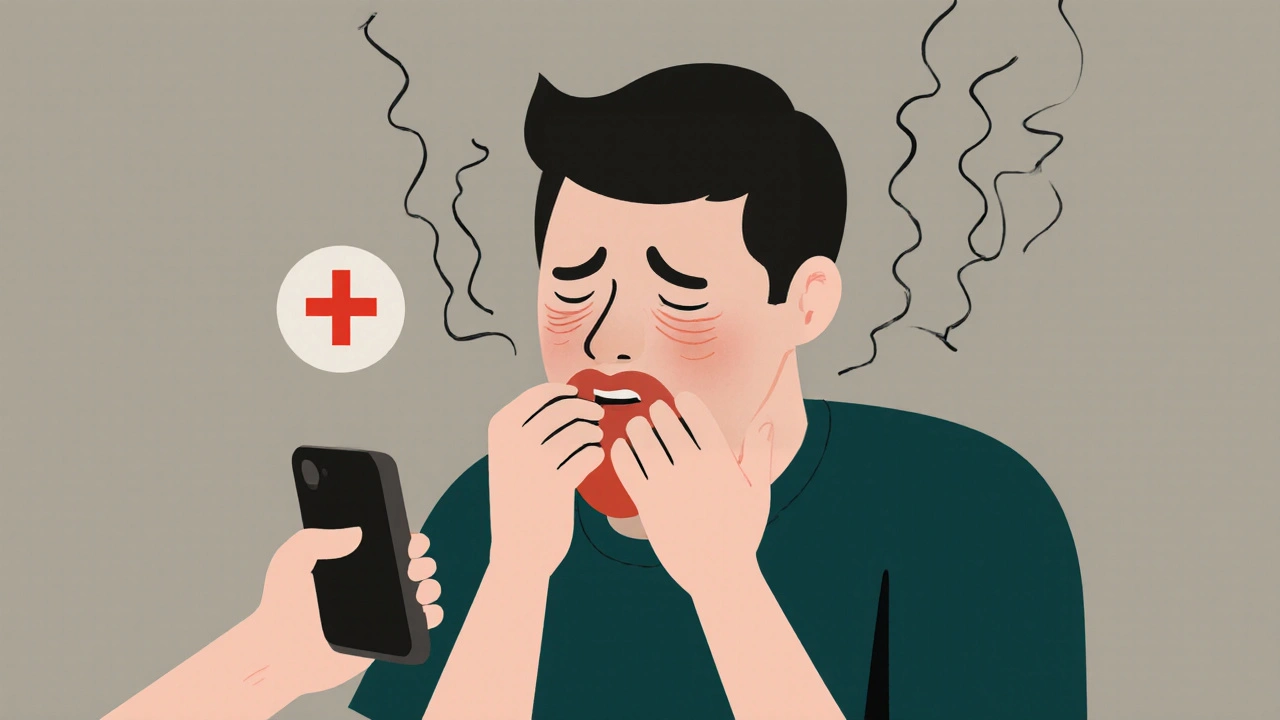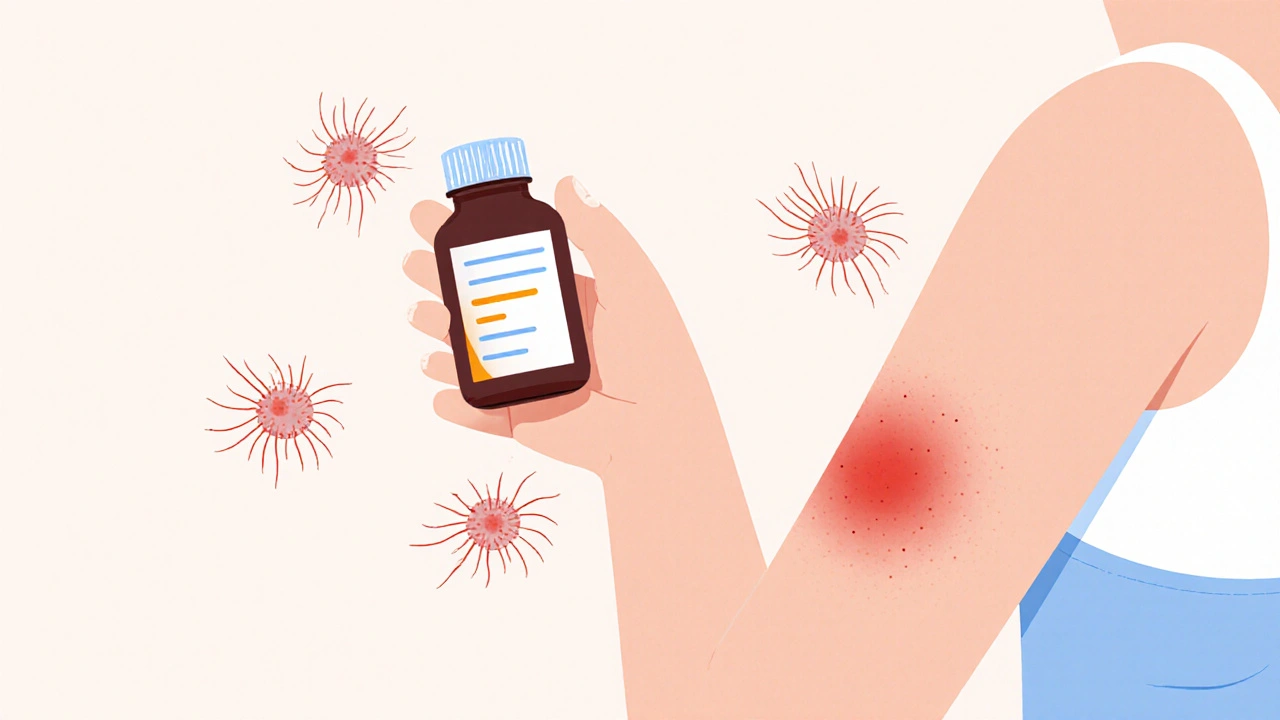More than 1 in 10 people in the U.S. believe they have a drug allergy. But here’s the truth: most of them don’t. A rash after taking amoxicillin? Maybe. Trouble breathing after ibuprofen? Possibly. But without proper evaluation, many people carry a label that changes their medical care forever - even if it’s wrong.
What Actually Counts as a Drug Allergy?
A drug allergy isn’t just a side effect. It’s not nausea from antibiotics or dizziness from blood pressure meds. Those are reactions, yes - but not allergies. A true drug allergy means your immune system sees the medicine as an invader and attacks it. That’s what triggers symptoms like hives, swelling, or trouble breathing. The most common sign? A rash. It might show up as red spots, raised bumps, or flat patches. It can itch badly or not at all. But here’s what makes it an allergy: it’s not predictable. One person gets a rash on penicillin. Another takes the same pill and feels fine. Your body’s response is unique.Common Signs of a Drug Allergy
Symptoms vary wildly. Some come fast. Others creep in over days. Knowing the difference can save your life.- Hives - raised, red, itchy welts that look like mosquito bites. They can appear anywhere, move around, and fade in hours.
- Swelling - especially around the lips, tongue, eyelids, or throat. This isn’t just puffiness. It’s deep tissue swelling called angioedema.
- Itching - without a rash. It can be intense, even if your skin looks normal.
- Difficulty breathing - wheezing, tight chest, feeling like you can’t get air in. This isn’t a cold. It’s your airways tightening.
- GI symptoms - vomiting, diarrhea, cramps. These often show up with skin or breathing issues.
- Fever and joint pain - especially if they show up 1-3 weeks after starting a new drug. This could be serum sickness.
- Blisters or peeling skin - if your skin starts to slough off, especially around the mouth, eyes, or genitals, this is a medical emergency.
When Is It an Emergency?
Anaphylaxis is the most dangerous drug reaction. It hits fast - usually within minutes to an hour after taking the drug. It affects two or more body systems at once. Think: hives and trouble breathing. Swelling and vomiting. Dizziness and a racing heartbeat. If you’re experiencing any of these:- Swelling of the throat or tongue
- Wheezing or gasping for air
- Feeling faint, dizzy, or passing out
- Rapid pulse or cold, clammy skin
Call 911. Don’t wait. Don’t drive yourself. Epinephrine is the only thing that can stop this reaction, and it works fastest when given right away. Emergency rooms have it. Ambulances carry it. Time is everything.
Delayed Reactions Can Be Just as Dangerous
Not all drug allergies strike right away. Some show up days or even weeks later. These are harder to link to the medicine - but just as serious.- Drug rash with eosinophilia and systemic symptoms (DRESS) - starts as a rash, then fever, swollen lymph nodes, liver damage. It can hit 2-6 weeks after starting a drug. Common culprits: antiseizure meds, allopurinol, some antibiotics.
- Stevens-Johnson Syndrome (SJS) and Toxic Epidermal Necrolysis (TEN) - blistering, peeling skin, mouth sores, eye pain. TEN can kill. If more than 30% of your skin peels off, it’s TEN. This isn’t a bad sunburn. It’s a medical emergency.
These reactions don’t always start with a rash. Sometimes, you feel like you have the flu - fever, fatigue, sore throat - then the skin starts to break down. If you’ve recently started a new drug and your skin is changing, get to a hospital immediately.

Why Misdiagnosis Is a Big Problem
You might think, “I had a rash once, so I’m allergic to penicillin.” But here’s the catch: more than 90% of people who say they’re allergic to penicillin turn out not to be. Why? Because they had a virus at the same time, or the rash was from something else. But because of that label, doctors avoid penicillin. They give you something stronger, more expensive, and riskier. You might end up with a deadly infection like C. diff - because the alternatives wipe out good gut bacteria. The NIH estimates mislabeling costs the U.S. healthcare system billions each year. And it’s not just money. It’s risk. It’s longer hospital stays. It’s unnecessary suffering.What Should You Do After a Reaction?
If you have a mild reaction - like a small rash that goes away after stopping the drug - don’t ignore it. Write it down. Note:- What drug you took
- When you took it
- What symptoms you had
- How long they lasted
Take a photo of any rash. Skin changes fade fast. A picture helps your doctor later.
Then, call your doctor. Don’t assume it’s harmless. Even a small reaction could be a warning sign.
If you had a serious reaction - breathing trouble, swelling, blistering - you need to see an allergist. Not just any doctor. An allergist or immunologist. They know how to test for true allergies.
How Are Drug Allergies Tested?
There’s no blood test for most drug allergies. The only widely accepted test is for penicillin. For penicillin:- First, a skin prick test. A tiny drop of penicillin is placed on your skin, then lightly pricked. If you’re allergic, a red bump appears.
- If that’s negative, you get a small oral dose - just a sip of liquid penicillin - under close watch.
- If you stay symptom-free, you’re not allergic. That’s it.
For other drugs? It’s trickier. Sometimes, doctors use a graded challenge - giving tiny, increasing doses over hours to see if you react. This only happens in a clinic with emergency equipment on hand.
For severe delayed reactions like DRESS, a blood test might check for elevated white blood cells or liver enzymes. But there’s no single test that says “yes, you’re allergic to sulfa.” Diagnosis is still mostly based on your history and timing.

What to Do If You’re Labeled Allergic - But You’re Not Sure
If you’ve been told you’re allergic to a drug - especially penicillin - and you’ve never had a confirmed test, talk to your doctor about getting evaluated. You might be able to safely take it again. Many people avoid penicillin because their parents told them they were allergic. Or they had a rash as a kid and were told to never take it again. That label sticks. But science says: get tested. Allergists can help you safely remove incorrect labels. That means better treatment options. Fewer side effects. Lower costs. And less risk of dangerous infections.How to Protect Yourself Moving Forward
- Always tell every doctor, dentist, and pharmacist about any drug reaction you’ve had - even if you think it’s minor. - Carry a list of drugs you’re allergic to - or suspect you’re allergic to - in your wallet or phone. - Wear a medical alert bracelet if you’ve had anaphylaxis or SJS/TEN. - Don’t self-diagnose. If you get a rash after a new drug, don’t assume it’s the medicine. Viruses, infections, and other drugs can cause similar symptoms. - Don’t avoid all drugs in the same class just because you reacted to one. Allergies aren’t always cross-reactive. Only an allergist can tell you what’s safe.Final Thought: Your Body Knows - But You Need to Listen
Drug allergies aren’t common. But when they happen, they can be life-changing. The key isn’t fear. It’s awareness. If you feel something strange after taking a pill - especially if it’s new - pay attention. Write it down. Take a picture. Talk to your doctor. Don’t let a guess become a lifetime label. And don’t wait until you’re gasping for air to realize you need help.How do I know if my rash is from a drug or something else?
A drug rash usually appears 1-14 days after starting a new medication. It often looks like red spots or bumps, may itch, and doesn’t respond to typical allergy creams. If you’ve taken a new drug and the rash shows up within that window, it’s likely related. But viruses, infections, and other conditions can mimic it. The best way to know? Talk to your doctor and share your medication history. A photo helps.
Can I outgrow a drug allergy?
Yes. Many people, especially those labeled with penicillin allergy in childhood, lose their sensitivity over time. Studies show more than 90% of people who think they’re allergic to penicillin can tolerate it after proper testing. Allergies don’t always last forever - but you need a doctor to confirm it’s safe.
Is it safe to take a similar drug if I’m allergic to one?
Not necessarily. Some drugs in the same class - like different penicillins - can cross-react. Others, like sulfa drugs, have very specific triggers. But it’s not guaranteed. For example, being allergic to amoxicillin doesn’t mean you can’t take cefdinir. Only an allergist can test for cross-reactivity. Never assume safety based on drug class alone.
Can I have a drug allergy without a rash?
Absolutely. Some people have anaphylaxis with just swelling, wheezing, or low blood pressure - no rash at all. Others get severe stomach cramps or vomiting as the only sign. Don’t wait for a skin reaction. If you feel like something’s seriously wrong after taking a drug - especially if multiple systems are involved - treat it as an emergency.
Should I carry an EpiPen for every drug allergy?
Only if you’ve had anaphylaxis before. If your reaction was just a rash or mild swelling, you likely don’t need one. But if you’ve ever had trouble breathing, throat swelling, or passed out after a drug - yes, carry an EpiPen. Talk to your allergist about when and how to use it. Don’t wait for the next reaction to decide.
Can I be allergic to a drug I’ve taken before without problems?
Yes. Your immune system can change. You might take amoxicillin five times without issue - then suddenly develop hives on the sixth. That’s not rare. It’s how allergies work. Once your body has been exposed, it can start recognizing the drug as a threat. Always pay attention, even to meds you’ve used before.
What if I’m allergic to a drug I need for a serious condition?
That’s why allergists exist. For life-saving drugs like insulin, chemotherapy, or certain antibiotics, doctors can use a process called desensitization. It involves giving tiny, gradually increasing doses under close supervision. It’s not risk-free, but it’s done safely in hospitals every day. Don’t assume you’re out of options - talk to a specialist.


Written by Felix Greendale
View all posts by: Felix Greendale